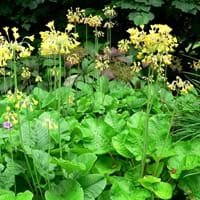Life Span
Perennial
Perennial
Origin
Eastern Europe, Southern Europe, Russia/Siberia, Southern Asia, Western Asia
Southeastern United States, North-Central United States, Central United States, South-Central United States, Southwestern United States, Texas, Canada, Mexico
Types
Not available
Not Available
Habitat
Roadsides, sand dunes, Waste areas
Dry areas, Prairies, Rocky areas, rocky outcrops
USDA Hardiness Zone
6-9
3-10
Sunset Zone
1a, 1b, 2a, 2b, 3a, 3b, 4, 5, 6, 7, 8, 9, 14, 15, 16
A1, A2, A3, H1, H2, 1a, 1b, 2a, 2b, 3a, 3b, 4, 5, 6, 7, 8, 9, 10, 11, 12, 13, 14, 15, 16, 17, 18, 19, 20, 21, 22, 23, 24
Habit
Oval or Rounded
Upright/Erect
Flower Color
Pink, Hot Pink, Rose
Yellow, Purple, Burgundy, Light Green, Brown
Flower Color Modifier
Bicolor
Bicolor
Fruit Color
Yellow, Yellow green, Pink, Dark Red
Brown
Leaf Color in Spring
Green
Light Green, Gray Green
Leaf Color in Summer
Green
Light Green, Gray Green
Leaf Color in Fall
Green, Light Yellow, Brown
Light Green, Gray Green
Leaf Color in Winter
Light Green
Light Green
Leaf Shape
Oblong
Subulate
Plant Season
Summer
Summer
Sunlight
Full Sun, Partial Sun
Full Sun
Type of Soil
Loam, Sand
Loam, Sand
The pH of Soil
Acidic, Neutral, Alkaline
Neutral
Soil Drainage
Well drained
Well drained
Bloom Time
Early Summer, Summer, Late Summer
Late Spring, Early Summer, Summer, Late Summer
Tolerances
Drought
Drought
Where to Plant?
Container, Ground, Pot
Ground
How to Plant?
Divison, Seedlings, Stem Planting
Seedlings
Plant Maintenance
Low
Medium
Watering Requirements
Average Water Needs, Do Not over Water, Never Over-water, Requires regular watering, Water more in summer
Average Water Needs, Water in morning to avoid prompting diseases
In Summer
Lots of watering
Lots of watering
In Spring
Moderate
Moderate
In Winter
Average Water
Average Water
Soil pH
Acidic, Neutral
Neutral
Soil Type
Loam, Sand
Loam, Sand
Soil Drainage Capacity
Well drained
Well drained
Sun Exposure
Full Sun, Partial Sun, Partial shade
Full Sun
Pruning
Remove damaged leaves, Remove dead branches, Remove dead leaves
Cut or pinch the stems, Pinch Tips, Remove damaged leaves, Remove dead branches, Remove dead flowers, Remove dead leaves, Remove dead or diseased plant parts, Remove deadheads
Fertilizers
All-Purpose Liquid Fertilizer, fertilize in growing season
All-Purpose Liquid Fertilizer, Apply N-P-K
Pests and Diseases
Slugs, Snails
Pests and diseases free, Red blotch
Plant Tolerance
Variety of soil types
Drought, Dry Conditions, Dry soil, Full Sun
Flower Petal Number
Single
Single
Foliage Texture
Medium
Fine
Foliage Sheen
Matte
Matte
Attracts
Not Available
Birds, Butterflies
Allergy
Abdominal pain, Constipation, Diarrhea, Skin irritation
Rhinitis
Aesthetic Uses
Beautification, Borders, Landscape Designing, Showy Purposes
Borders
Beauty Benefits
Good for skin, Making cosmetics, Stops hair loss
Not Available
Environmental Uses
Air purification, Food for insects, Versatility
Air purification
Medicinal Uses
Eczema
Analgesic
Part of Plant Used
Root
Flowers
Other Uses
Decoration Purposes, Medicinal oil, Showy Purposes, Used as Ornamental plant, Used for its medicinal properties
Can be made into a herbal tea, Used in making tea
Used As Indoor Plant
Yes
No
Used As Outdoor Plant
Yes
Yes
Garden Design
Edging, Feature Plant, Groundcover, Mixed Border
Container, Cutflower, Mixed Border, Wildflower
Botanical Name
MALUS domestica 'Pink Pearl'
RATIBIDA columnifera
Common Name
Apple, Eating Apple, Pink Pearl Apple
Mexican Hat
In Hindi
Tibetan cowslip
Mexican Hat
In German
Tibet-Primel
Mexican Hat
In French
Kauslip tibétain
Mexican Hat
In Spanish
Primula florindae
mexican Hat
In Greek
Primula florindae
Mexican Hat
In Portuguese
cowslip tibetana
Mexican Hat
In Polish
tybetański cowslip
Mexican Hat
In Latin
Primula florindae
Mexicanus Hat
Phylum
Magnoliophyta
Tracheophyta
Class
Magnoliopsida
Magnoliopsida
Family
Onagraceae
Asteraceae
Clade
Angiosperms, Eudicots, Rosids
Angiosperms, Asterids, Eudicots
Tribe
Onagreae
Not Available
Subfamily
Onagroideae
Not Available
Number of Species
Not Available
Season and Care of Tibetan cowslip and Mexican Hat
Season and care of Tibetan cowslip and Mexican Hat is important to know. While considering everything about Tibetan cowslip and Mexican Hat Care, growing season is an essential factor. Tibetan cowslip season is Summer and Mexican Hat season is Summer. The type of soil for Tibetan cowslip is Loam, Sand and for Mexican Hat is Loam, Sand while the PH of soil for Tibetan cowslip is Acidic, Neutral, Alkaline and for Mexican Hat is Neutral.
Tibetan cowslip and Mexican Hat Physical Information
Tibetan cowslip and Mexican Hat physical information is very important for comparison. Tibetan cowslip height is 370.00 cm and width 460.00 cm whereas Mexican Hat height is 30.00 cm and width 30.50 cm. The color specification of Tibetan cowslip and Mexican Hat are as follows:
Tibetan cowslip flower color: Pink, Hot Pink and Rose
Tibetan cowslip leaf color: Green
Mexican Hat flower color: Yellow, Purple, Burgundy, Light Green and Brown
- Mexican Hat leaf color: Light Green and Gray Green
Care of Tibetan cowslip and Mexican Hat
Care of Tibetan cowslip and Mexican Hat include pruning, fertilizers, watering etc. Tibetan cowslip pruning is done Remove damaged leaves, Remove dead branches and Remove dead leaves and Mexican Hat pruning is done Cut or pinch the stems, Pinch Tips, Remove damaged leaves, Remove dead branches, Remove dead flowers, Remove dead leaves, Remove dead or diseased plant parts and Remove deadheads. In summer Tibetan cowslip needs Lots of watering and in winter, it needs Average Water. Whereas, in summer Mexican Hat needs Lots of watering and in winter, it needs Average Water.





